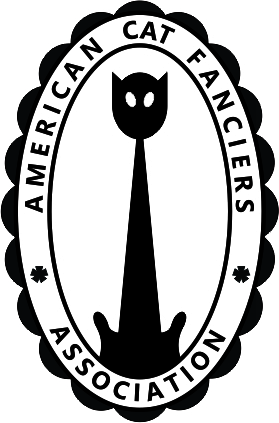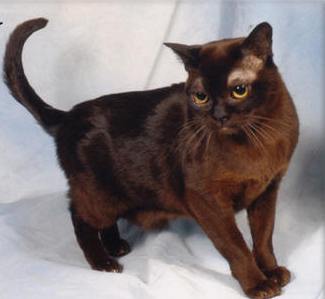 American Cat Fanciers Association
American Cat Fanciers Association
Burmese Breeders' Directory
~~~~~~~~~~~~~~~~~~~~~~~~~~~~~~~~~~~~~~~~~~~~~~~~~~~~~~~~~~~
This is a remarkable cat wrapped in satin. They come in sable, champagne, blue and platinum. It makes no difference what the color is, Burmese are like no other cat. They have a sweet innocent look, yet wear a faint smile that will keep you wondering what secret they are harboring.
One secret they all know, is that once you are exposed to them for any
length of time, you must have a Burmese of your very own. They are like
good chocolates, impossible to resist. Wrapped in that tight lying,
single coat, is a round, muscular cat with a short, stocky body. When
you pick one up, you are surprised at their weight. They have
substantial boning with a broad chest that gives them the appearance of
being bowlegged. Yet there is no awkwardness about them. They can flow
across the room and float to the tops of doors. And once there, they
look down on you, waiting to see if you know where they are. You can
call and search to no avail until you see them there. Then with sparking
mischievous eyes, they act as if they were unaware of your search.
CHARACTERISTICS and TEMPERAMENT:
Burmese never grow up! They play all of their life. They roughhouse with wild abandonment with their littermates and will even take on older cats. When they become adults, they will entertain their people for hours tirelessly playing fetch and lying in ambush to pounce on any body part that moves. They may be the most intelligent cats, and they can certainly outwit Siamese. No closet is safe from their inspection if it has fan-fold doors. One female that I know is certain that it is her duty to open all closet doors for the poor Siamese. Then she sits back and smirks because the poor Siamese got caught riffling through shelves. It is not necessary for her to go in, after all she remembers what is in the closet.
The females try to run the household, following you from room to room. They will help make up the beds, steal your pen if you are writing letters and lie on the middle of your book or newspaper you are reading. I'm certain that very soon, one of the females will take over the computer keyboard and then, look out, Internet!
The males are not as determined to boss you as the girls, but they too will jump into the middle of the floor you are mopping or sweeping. I had one boy that wanted to be vacuumed and now one of his great-granddaughters also insists on getting herself vacuumed. They will sit in your lap and watch TV, plaster themselves next to your head when you are trying to sleep or insist on climbing under the covers. The males are very laid-back, ready to just hang out with you, yet with a definite sense of humor. I once knew an Alter that liked to lie in a cozy bed on top of a show cage. He just lounged there, watching people go by until someone realized there was a real cat sitting there grinning at them. Upon discovery, he would stretch his head out for a little ear scratch and never think about getting down or wondering off.
Burmese are totally people-oriented. If you don't enjoy being with an animal, that wants to supervise, interact, demand affection and discuss (in a very soft conversational tone) daily activities, yours and theirs, then a Burmese is not for you.
HISTORY OF BURMESE
The first Burmese was brought to this county and given to Dr. Joseph
G. Thompson, who lived in San Francisco. He was a retired ship's doctor
of the US Navy and a very unusual character with a deep interest in the
East. Dr. Thompson named her Wong Mau, and he considered her a new
variety of Malay-type cat. She was without doubt a hybrid - a
Burmese/Siamese mix.
Dr. Thompson enlisted the help of two prominent breeders, Virginia Cobb
(Newton cattery) and Billie Gerst (Gerstdale cattery) and Dr. Clyde E.
Keeler. The four of them developed and established an experimental
breeding program. Since Siamese were considered the closest in
appearance, they were used in the breeding program. After two
generations, this program resulted in kittens with three distinct
colorations: some looked just like Siamese, some looked like Wong Mau
(with medium brown body color and darker points and some a solid
dark-chocolate brown color. The later were considered the most
attractive and the breeding program was aimed at isolating the genetic
makeup of the phenotype.
Discovering that these dark brown cats could indeed breed true,
consistently producing dark brown cats, while the walnut brown variety,
such as Wong Mau herself, continued to produce kittens in the three
variations of coloration, the theory that Wong Mau was the first
Tonkinese was proved. The results of the original experimental breeding
program were published in the April 1943 Journal of Heredity,
"Genetics of the Burmese Cat," by the four program
participants cited above.
Unfortunately, Dr. Thompson did not live to see this paper published. He died of a heart attack while the paper was in publication. This breeding program established the American Burmese. A proposal was made to CFA (Cat Fanciers Association) for acceptance as a new breed in 1934, and Burmese were approved for stud book registration in 1936.
Once Burmese began to be exhibited, they became very popular with a great demand for kittens. Breeders to increase the very limited breeding used Siamese stock, thus producing lots of hybrids. Since we now speculate that Siamese, recognized then only in seal points, may have been carrying the other colors, chocolate, blue and lilac, it would appear reasonable that the Burmese colors, champagne, blue and platinum came from the Siamese out crosses. CFA registration was suspended in 1947 when that registering body would no longer allow this, after all either the Burmese were a breed of their own or they weren't. Serious breeders then concentrated on breeding the type of cat that makes this breed unique and were successful in being reinstated by CFA for registration in 1953. They were then returned to championship competition in 1957. A standard was formulated to express the ideal of the original vision and to emphasize the difference between the Burmese and the Siamese. CFA adopted the standard in 1959 and it has changed very little since then.
Because of ideological differences, with CFA, some members broke away and established ACFA (American Cat Fanciers Association) a new democratic Association in 1955. In 1961, ACFA registered 135 Burmese, One of which was Mizpah's Ferdnand of Briarwood, owned by John E Baker. Ferdnand continued his career to become ACFA's Royal InterAmerican Best Cat. He became the first shorthair to win that position, but not the last Burmese to gain that title.
The 1960's produced many outstanding Burmese which are the foundation of the cats today. Most of the Burmese of today can claim these 'stars' of the past in their pedigrees. Mizpah's Ferdnand of Briarwood was on of those illustrious cats. Ferdnand made commercials for the litter Evergreen perched on his owner's shoulders. Many of us can remember seeing Ferdnand traveling around show halls, draped around John's shoulders. Other famous names were Fongin Chop Soy, Hill House Daniella of Shawnee and Shawnee Casey Jones of Phi Line. Nikki Horner used to take up both sides of a show isle with her Shawnee entries and all the cages were dressed in her distinctive yellow cage curtains. Burma Road's Detour of Senshu also was part of that group of outstanding cats.
FOLK TALES OF THE BURMESE
Most breeds have interesting stories about their beginnings and the
Burmese are no exception. There is a story that the Copper Cats of Siam
are perhaps the earliest ancestors of the Burmese. The Cat Book of Poems
about 1350, preserved in the University of Bangkok Art Department Museum
clearly shows our little brown cat with gold eyes. It is said that they
can be found today in the natural state in some temples.
Burmese were called the temple guards because of their distinctive
eyebrows, (the bare spots above their eyes) which gave the impression to
birds and animals that their eyes are always open. They were given to
young monk novitiates to raise as part of their training. Perhaps the
Burmese did the actual training of the monks.
Those of us who live with Burmese are well aware that we are carefully
trained and allowed to share our lives with these four-footed friends.
|
Dolores Kennedy Email: doloreskennedy@twc.com Cattery Name: Delian |
(502) 491-8980 |
Jeffersontown, KY |
|
Betty Sue Kremer
|
(502) 425-1557
|
Louisville, KY
|
Breed Chair Jeffersontown, KY
Dolores Kennedy
Email:
doloreskennedy@twc.com
